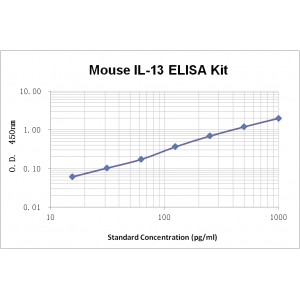More info
Assay Range | 15.6--1000 pg/mL |
Sensitivity | 2.0 pg/mL |
Specificity | No cross-reaction with other related substances detected |
Size | 96T |
Storage | Store at 2 - 8ºC. Keep reconstituted standard and detection Ab at -20 ºC |
Assay Principle | Sandwich ELISA |
Sample Volume | 100 µL final volume, dilution factor varies on samples |
Sample Type | serum, plasma or cell culture supernatant |
Detection Method | Chromogenic |
Kit Components
1. Recombinant Mouse IL-13 standard: 2 vials
2. One 96-well plate coated with Mouse IIL-13 Ab
3. Sample diluent buffer: 12 mL — 2
4. Detection antibody: 130 µL , dilution 1:100
5. Streptavidin-HRP: 130 µL , dilution 1:100
6. Antibody diluent buffer: 12 mL x1
7. Streptavidin-HRP diluent buffer: 12 mL x1
8. TMB developing agent: 10 mL x1
9. Stop solution: 10 mL x1
10. Washing solution (20x): 25 mL x1
Background
Interleukin 13 (IL-13) is a cytokine encoded by the IL-13 gene in humans. Mouse IL-13 is synthesized as a 131 amino acid (aa) precursor protein containing a 20 aa signal peptide and a 111 mature protein. At the amino acid sequence level, mature mouse IL-13 is approximately 58% identical to human IL-13. While human and mouse IL-13 exhibit equal activity on human cells, human IL-13 is much less active than mouse IL-13 on mouse cells. IL-13 shares approximately 30% aa sequence with IL-4. The IL-13 receptor complex consists of IL-13 Rα and the IL-4 Rα. Interestingly, This IL-13 receptor complex may also serve as an alternate high-affinity IL-4 receptor complex in IL-4 responsive cells that lack the γc chain. IL-13 plays a role in regulating differentiation and activities of monocytes/macrophages. It can suppress the cytotoxic activities of monocytes/macrophages and their production of pro-inflammatory cytokines.


